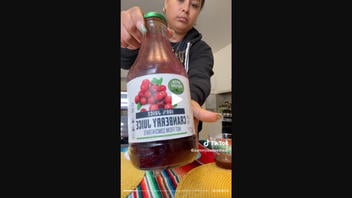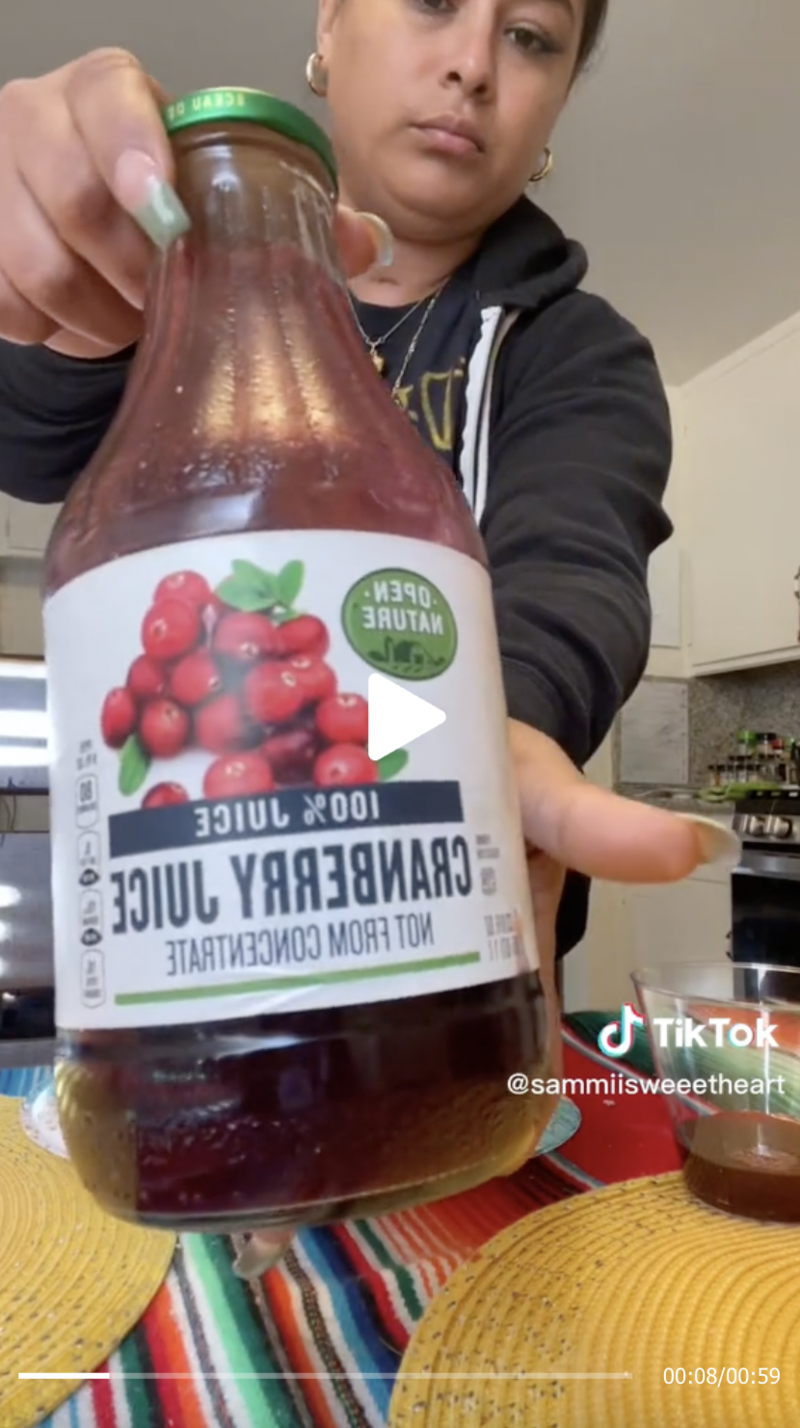
Does a test that supposedly extracts "chemtrail" and air-pollution nanoparticles from a person's saliva accurately show a diagnosis of Morgellons disease? No, that's not true: Food chemistry experts told Lead Stories that precipitates created after swishing cranberry juice in the mouth are not the result of nanoparticles from chemtrails and air pollution but a well-known reaction of saliva mixed with acerbic drinks.
The medical community currently regards Morgellons disease as a mental disorder that might also be a dermatological condition and needs further study. Nanoparticles, by definition, cannot be seen with the naked eye. Experts from several fields have debunked chemtrails as a longstanding conspiracy theory.
The claim about the supposed test appeared in a post on TikTok on March 16, 2023. The caption opened:
This made my stomach ache #eww
This is what the post looked like on TikTok at the time of the writing of this fact check:
(Source: TikTok screenshot taken on Fri Apr 21 19:29:23 2023 UTC)
Twenty-six seconds into the video, the unseen male narrator claims that swishing around cranberry juice in the mouth for "one to two minutes" will "pull out all these nanoparticles from the chemtrails, from the pollution in the air that gets absorbed in your mouth throughout your life." ("Chemtrails" refers to the conspiracy theory that traces of poisonous chemicals have been released deliberately into the atmosphere.)
The audio in this video originated from the former Instagram account of user @consciouss_thoughts. The audio previously appeared in this TikTok post on January 15, 2023.
According to the Mayo Clinic, Morgellons disease is defined as an "unexplained skin condition ... characterized by a belief that parasites or fibers are emerging from the skin."
The "demonstration" seen in this video is not a regulated scientific test. The viewer can't tell where the liquid in the glass came from. It is not clear that the mouth of the woman doing the demonstration does not contain any other chemical agent that affects how her saliva interacts with the other substances.
In an April 21, 2023, email, Joe Schwarcz, a chemistry professor at Canada's McGill University and director of its Office for Science and Society, confirmed to Lead Stories that the claim is false. Schwarcz called Morgellons syndrome "a fascinating disease," but noted that most members of the scientific community believe it to be delusional. He added:
I'm not sure why these TikTok videos claim that the test they are performing is a test for Morgellons since the people doing the test do not say that they have the disease.
Though Schwarcz noted that "some evidence" suggests that Morgellons syndrome could be connected with spirochete bacteria -- a bacteria that can cause human diseases -- he supported the conclusion of a fact check by the site Health Feedback that concluded that substances formed by swishing around cranberry juice in the mouth can be attributed to a chemical reaction with tannins in the juice:
I think the explanation provided about salivary proteins and tannins, which chemically are a class of water-soluble polyphenols, is correct. There actually have been a number of studies examining the reaction between polyphenols and proteins in saliva because it is thought to play a role in the perception of astringency. The salivary proteins are adsorbed onto surfaces in the mouth and offer protection against damage. On exposure to polyphenols they form insoluble aggregates, meaning the protective layer is removed and this is then sensed as astringency. It makes sense that swishing cranberry juice in the mouth will cause these aggregates to form and lead to their precipitation . . .
Needless to say the suggestion that these particles are some sort of nano robots, as one video claims, that are 'put into the environment to act as a conduit for frequencies transmitted in air from towers that are not really cell phone towers,' is sheer lunacy. Just when you think you have heard of the dumbest thing ever, and I have heard a lot of these, something comes around that is even more ridiculous.
In response to a Lead Stories query, Cordelia Running, founder of the SPIT Lab, which deals with the interaction of saliva and food, and associate professor of nutrition science at Purdue University, wrote in an April 21, 2023, email that existing scientific findings do not substantiate the video's claim:
But, there are literally decades--maybe almost a century--of data verifying that most people's saliva will react with molecules that are naturally present in cranberry juice. Those molecules include tannins and other polyphenols (that's a chemical term for the shape of the molecule). When saliva mixes with products, like cranberry juice, that contain polyphenols, some of the salivary proteins and the polyphenols stick together. This creates solids that grow bigger and bigger. As these combined polyphenol/saliva protein solids get larger, they become visible and 'precipitate out' of solution--basically, after mixing the saliva and juice, you start to see chunks floating around.
It has nothing to do with air pollution.
Running also took issue with the video's use of the word "nanoparticles."
'Nanoparticles' is a word for anything on the 'nano' scale. 'Nano' is a prefix in the metric system to indicate what size range something is, similar to 'micro' or 'milli' or 'centi.' So a 'nanoparticle' is generally speaking anything in the nanometer range of physical size. So no idea what the person in the post means by that. Could literally be anything.
Additional Lead Stories fact checks of claims about "Morgellons" and "chemtrails" can be read here and here.
















